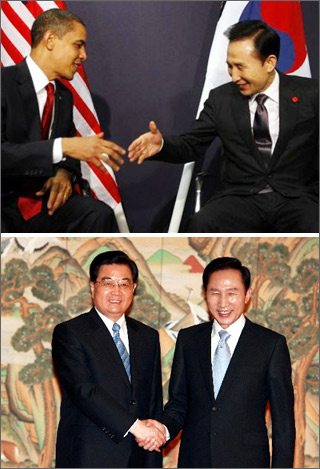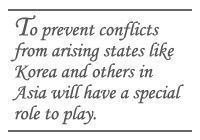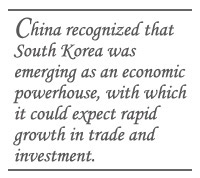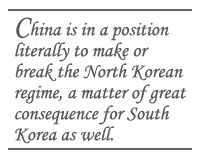The Koreas: A Tale of Two Triangles
The Koreas: A Tale of Two Triangles

CHICAGO: Despite the effort to promote cooperation and confidence building in the military areas between China and the United States, the two are suspicious of and attempt to constrain each other with counter-balancing acts such as strengthening existing alliances respectively like that with North and South Korea. To prevent conflicts from arising from such competition, and to build a foundation for mutual checks and balances, states like Korea and others in Asia will have a special role to play. That role would confront them with the dilemma of choosing sides, staying independent, or trying to reconcile and bring the two powers together.
The United States is concerned about the growing defense budget of China, which is estimated to be much more than what China has publicly admitted, as much as $139 billion. Yet, in the economic area, the US-China bilateral trade deficit reached $257 billion in 2007. The United States is China’s largest trading partner and China is the second largest trading partner of the US after Canada.

This is where countries such as South Korea, who are military allies or strong economic partners with the U.S. and China, can play a large part to counter-balance the competition. Even though China represents the largest importer of Korean goods ($112 billion in 2007), some 30 percent or a substantial portion of its exports to China ultimately end up as exports to the United States. It means that the United States effectively remains the number one importer of Korean goods.
Until the end of the 1980s, China and the United States each had close and exclusive relationships with separate halves of Korea. Since around 1990, however, an overlapping pair of triangles has emerged—one between China, the U.S. and South Korea on the one hand, and the other between the United States, China and North Korea. How would the overlapping triangles affect each other and how would they shape global transformations?
The balance between ideologically-aligned alliance of China and North Korea on the one hand, and the U.S. and South Korea on the other, began to shift during the collapse of the Soviet Union. The effects were not fully felt in Korea until 1991 and 1992 when the Soviet Union eventually "switched sides," and China "shifted its ground," as the eminent journalist Don Oberdorfer described in his book, The Two Koreas: A Contemporary History.
Normalization of relations between China and South Korea in 1992 led to a transformation in the Cold War triangular relationships. What prompted China to "abandon" North Korea and recognize the South? In the larger scheme of things, the end of the Cold War and Sino-American accommodation led China to normalize relations with South Korea. China also recognized that South Korea was emerging as an economic powerhouse, with which it could expect rapid growth in trade and investment. Thus, the foremost reason for Beijing to seek normalization with Seoul was economic.
Since normalization, relations between China and South Korea relations have expanded rapidly, especially in the economic arena. Trade volume, which was barely over $8 billion in 1992, exceeded $100 billion by 2007. In 2008, South Korea became the 3rd largest investor ($40 billion) in China and thus an important source of investment and technology.

As the only country with any real influence over North Korea, China has played a crucial and constructive role in times of crisis. China is also important as a signatory of the Armistice Agreement that ended the Korean War. At present, China finds itself caught between Pyongyang which insists on terminating the Armistice in favor of a peace treaty with the United States on the one hand, and Washington and Seoul which argue on the other hand that the Armistice should be abided by until it is replaced by an alternative peace structure.
As for North Korea, its very survival depends upon Beijing's generosity. Already China has been providing large amounts of food to North Korea and accounts for some 80 percent of DPRK's meager oil imports. Thus China is in a position literally to make or break the North Korean regime, a matter of great consequence for South Korea as well.
With the end of the Cold War amid changing national interests and international environment, the US also considered adopting a more positive position toward North Korea. But with the discovery that North Korea had been developing a nuclear weapons program the US-North Korea relations have remained frozen since 1990.

The Clinton administration eventually succeeded in putting a lid on the North Korean nuclear issue in 1994 but ran out of time to normalize relations before the end of its term in 2000. The Bush administration, which initially branded North Korea as a member of the Axis of Evil refused to engage in bilateral negotiation. However, after North Korea tested a nuclear bomb in October 2006, the U.S. made a turnabout in early 2007 and tried to coax Pyongyang into resolving the nuclear issue through bilateral negotiations until its time too ran out by the end of 2008.
As North Korea tries to use its nuclear and missile programs, as demonstrated by its recent test launch of long-range missile, to improve its bargaining position vis-à-vis the US and consolidate the regime at home, it is up to the Obama Administration to decide whether it will pick up where the Bush Administration left off or hew a new course.
China on its part wants a nuclear-free Korean peninsula and has concerns about the effect of North Korea's nuclear ambitions on Japan's nuclear policy. However, China also wants to maintain what influence it has over North Korea. For these reasons, China took a neutral position, both in the International Atomic Energy Agency (IAEA) and in the United Nations, and kept urging both sides to resolve the issue through dialogue.

In the overlapping triangle of relations China tries to take a middle course. First, China wants to avoid its entanglement in a conflict on its immediate borders. Second, China wants to see North Korea stay afloat as a regime and a country. A two Koreas policy serves its interest by way of maintaining a useful buffer zone but also preventing a serious disruption, both security and demographic, on its borders. Third, China does not wish to see an unpredictable neighbor such as North Korea armed with nuclear weapons and missiles that can carry them to all parts of China, nor does it wish to see North Korean nuclear weapons serve as an incentive to other countries such as Japan to reconsider their non-nuclear weapons policy. Finally, China would like to expand its economically beneficial relationship with South Korea, as one of the largest sources of trade, technology, capital, and business know-how. In pursuing these conflicting goals, China has to cooperate with the United States and South Korea for the most part, although their views and approaches do not always coincide and need for competition with the US might prevail.
South Korea remains concerned that in their grand chess game, China and the US may place a disproportionate amount of emphasis on big power relationships at the expense of small and medium powers including South Korea. In the years to come, the most difficult challenge for South Korea will be to navigate carefully between China and the United States.
Han Sung-Joo, is Professor Emeritus of Korea University and Former Foreign Minister of the Republic of Korea. This essay is adapted from a keynote address given at the annual meeting of the Association for Asian Studies in Chicago in March 2009.